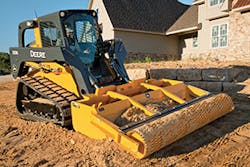The skid-steer and the compact track loader (CTL): two powerful little workhorses designed to perform the same basic functions—so what’s the difference? Hint: the difference is based on the working conditions each is best suited for.
“It all comes down to wheels versus tracks,” sums up Ashby Graham, product manager for JCB.
“Skid-steers are tired machines, whereas CTLs sit on a tracked undercarriage similar to a dozer,” elaborates Warren Anderson, brand marketing manager for CASE Construction Equipment.
The skid-steer and the compact track loader (CTL): two powerful little workhorses designed to perform the same basic functions—so what’s the difference? Hint: the difference is based on the working conditions each is best suited for. “It all comes down to wheels versus tracks,” sums up Ashby Graham, product manager for JCB. “Skid-steers are tired machines, whereas CTLs sit on a tracked undercarriage similar to a dozer,” elaborates Warren Anderson, brand marketing manager for CASE Construction Equipment. [text_ad] Skid-steers give the operator greater traction and maneuverability on paved surfaces, continues Anderson. They also have faster top travel speeds. “CTLs provide an incredibly stable platform. The primary advantage is lower ground pressure and stable operation over uneven or sensitive surfaces [because] the tracks provide more contact with the ground than four independent tires.” That’s the main difference, agrees Gregg Warfel, district sales manager for Terex Construction Americas, who says it’s important to assess the site conditions where the loader will be working. “The type of surface the machine will be working on significantly impacts the productivity and cycle times of the loader. When working in soft underfoot conditions, a loader with tracks will be more effective. When working on harder surfaces, a wheeled loader is better suited.” A key distinction between an skid-steer loader (SSL) and a CTL is the difference in ground pressure that machine delivers, notes Brent Coffey, product manager of loaders for Wacker Neuson. “Although CTLs are typically heavier than SSLs, they have less ground pressure, making [them] ideal for soft or muddy ground. On the other hand, an SSL has a higher travel speed and because of the tires, is best suited [for] operating on harder surfaces.” Besides the obvious difference of tires on skid-steer loaders and tracks on compact track loaders, the drive system and components differentiate the two machines. “Most SSL machines are driven with a hydraulic motor that is positioned near the center of the machine. They utilize a chain-drive system to turn the wheels,” explains Jorge De Hoyos, Kubota senior product manager, SSLs and skid-steer verticals. “Most track loaders have a hydraulic-drive motor with a sprocket on it to drive the track. There are additional rollers and idlers that make up the undercarriage system of a CTL machine.” Other differences include size and operator location. Andrew Schuermann, product manager of trenchers and compact utility equipment for Ditch Witch, describes SSLs as 35 horsepower and up “ride-in loader” machines on tires, and CTLs as 20–37 horsepower “stand-on” units on tracks. “They handle the same way, use the same attachments on the front, and perform a lot of the same functions,” he explains, “but the choice boils down to the job.”Skid-steers give the operator greater traction and maneuverability on paved surfaces, continues Anderson. They also have faster top travel speeds. “CTLs provide an incredibly stable platform. The primary advantage is lower ground pressure and stable operation over uneven or sensitive surfaces [because] the tracks provide more contact with the ground than four independent tires.”
That’s the main difference, agrees Gregg Warfel, district sales manager for Terex Construction Americas, who says it’s important to assess the site conditions where the loader will be working. “The type of surface the machine will be working on significantly impacts the productivity and cycle times of the loader. When working in soft underfoot conditions, a loader with tracks will be more effective. When working on harder surfaces, a wheeled loader is better suited.”
A key distinction between an skid-steer loader (SSL) and a CTL is the difference in ground pressure that machine delivers, notes Brent Coffey, product manager of loaders for Wacker Neuson. “Although CTLs are typically heavier than SSLs, they have less ground pressure, making [them] ideal for soft or muddy ground. On the other hand, an SSL has a higher travel speed and because of the tires, is best suited [for] operating on harder surfaces.”
Besides the obvious difference of tires on skid-steer loaders and tracks on compact track loaders, the drive system and components differentiate the two machines. “Most SSL machines are driven with a hydraulic motor that is positioned near the center of the machine. They utilize a chain-drive system to turn the wheels,” explains Jorge De Hoyos, Kubota senior product manager, SSLs and skid-steer verticals. “Most track loaders have a hydraulic-drive motor with a sprocket on it to drive the track. There are additional rollers and idlers that make up the undercarriage system of a CTL machine.”
Other differences include size and operator location. Andrew Schuermann, product manager of trenchers and compact utility equipment for Ditch Witch, describes SSLs as 35 horsepower and up “ride-in loader” machines on tires, and CTLs as 20–37 horsepower “stand-on” units on tracks. “They handle the same way, use the same attachments on the front, and perform a lot of the same functions,” he explains, “but the choice boils down to the job.”








